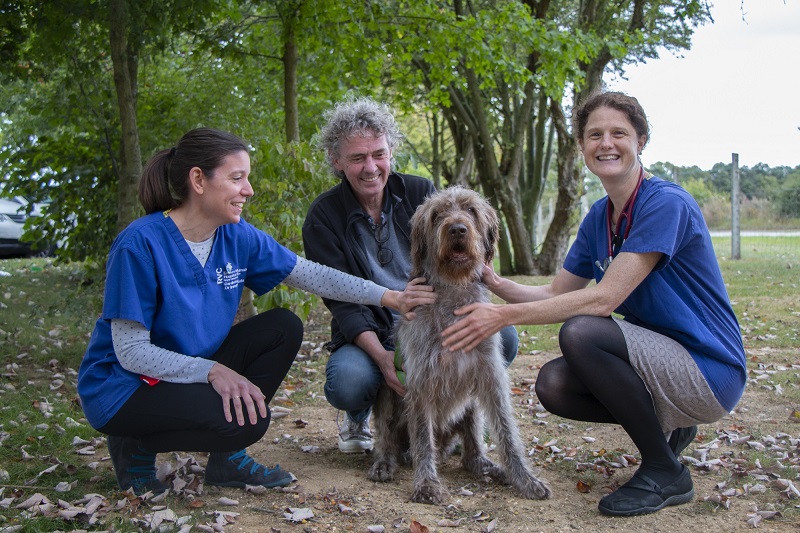Critical Care Case One Year On
Clinical Connections – Autumn 2019
A 15-year-old German long-haired pointer that presented with septic shock and was found to have pyothorax made a good recovery and has enjoyed more than a year of life since being treated and cared for at RVC Small Animal Referrals.
Toby was referred to the RVC late one evening last autumn with tachypnoea and collapse. On presentation he was laterally recumbent and mentally depressed. He had muffled heart sounds and weak peripheral pulses with a heart rate of 160bpm. His respiratory rate was elevated at 40bpm and he was pyrexic at 40.2C.
Point of care ultrasound (POCUS) revealed pleural fluid; diagnostic thoracocentesis was performed and a diagnosis of pyothorax was made. Bilateral chest drains were placed to aid stabilisation. The following morning thoracic and abdominal CT was performed, but no underlying cause for the pyothorax was found.
Outlining the case, co-head of Emergency and Critical Care Karen Humm said: “Toby is a lovely dog and was a challenging patient to treat. On presentation he was in severe septic shock and required intensive care with initial nor-adrenaline and dobutamine constant rate infusions to aid stabilisation, alongside broad spectrum intravenous antibiotic therapy (co-amoxyclav), high flow oxygen therapy and fluid therapy.
“At this point, taking into account Toby’s unstable condition, based on human literature and discussion between the Critical Care, Soft Tissue Surgery and Diagnostic Imaging Services and Toby’s owners, the decision was made to manage his pyothorax medically. After 24 hours, Toby's vital signs and blood gas parameters stabilised and therefore the constant rate infusions of noradrenaline and dobutamine were stopped. A naso-oesophageal (NO) tube was placed and parenteral feeding was started due to Toby's clinical improvement.”

During his time in hospital Toby developed vasculitis secondary to his inflammatory state and this resulted in bruising and oedema of his limbs. Toby was a big challenge for the ICU nursing team, due to the requirement for frequent physiotherapy to manage his oedema and arthritic pain (alongside analgesia), aseptic care of his chest drains and urethral catheter, frequent chest lavage and tube feeding, and the need for love and attention that all ICU patients require, but that was particularly important in a geriatric disorientated patient.
Toby's clinical condition steadily improved over the following week and he became alert and ambulatory. When he started to walk, this was a great moment for the whole team involved in his care. He also started to eat and therefore the NO tube was removed. Once the pleural fluid no longer had any cytological evidence of bacteria the chest drains were removed.
Upon discharge the importance of close monitoring to detect any signs of return of the pyothorax was explained to his owners. Deciding when to stop antibiotic therapy in these cases can be hard, Toby went home on oral antibiotics and CRP measurements were used to aid in making the decision to stop antibiotics after six weeks of therapy.
